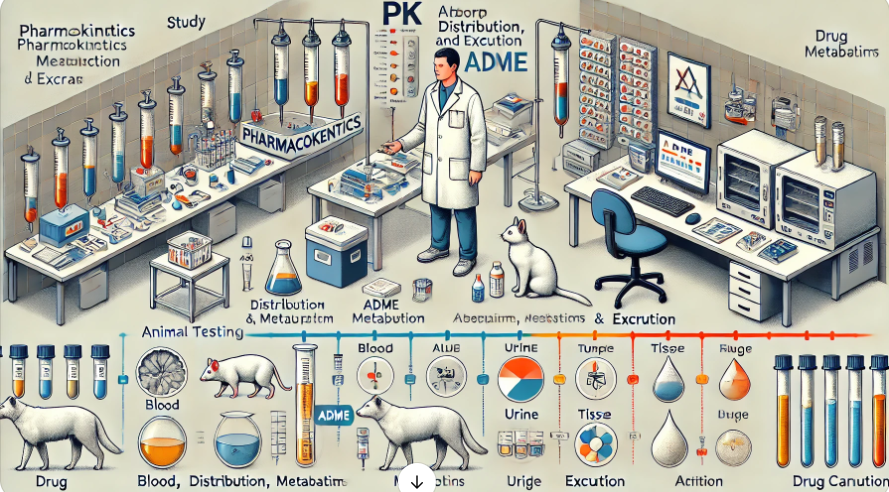Pharmacy Lab Equipment
Understanding Pharmacokinetics (PK) Studies in Animals
November 11, 2024 admin No Commentabsorption, distribution, metabolism, and excretion (ADME) of drugs in animals
Pharmacokinetics (PK) studies are essential to evaluate how a drug behaves in a biological system. The goal of PK studies is to understand how a drug is absorbed, distributed, metabolized, and excreted (ADME). These studies help researchers determine dosage, efficacy, and safety for further development of therapeutics.
Objectives of PK Studies
The main objective of PK studies is to gain insight into the drug’s journey within the body. Understanding ADME helps to:
- Determine appropriate dosages.
- Evaluate potential toxicity.
- Assess the drug’s effectiveness over time.
- Ensure safety in target species.

Experimental Procedures for PK Studies
1. Drug Administration
- Goal: To introduce the drug into the animal system in a controlled manner.
- Routes of Administration: Common routes include oral, intravenous (IV), intramuscular (IM), and subcutaneous (SC).
- Dosing Levels: Administer different dosing levels to determine how dosage influences PK properties.
2. Sample Collection
- Blood Samples: Collected at multiple intervals post-dosing to monitor plasma drug concentrations.
- Urine and Fecal Samples: Collected to understand excretion pathways.
- Tissue Samples: Taken to evaluate drug distribution within specific organs.
- Timing Intervals: Collection at pre-set intervals (e.g., 5 min, 15 min, 30 min, 1 hr, 3 hr, etc.) to map the concentration-time profile.
3. Analytical Techniques
- Chromatography and Mass Spectrometry: Used to measure drug concentration in samples.
- Spectrophotometry: For drugs detectable in the visible spectrum.
- Data Analysis: Generate concentration-time graphs to model ADME parameters.
Requirements for PK Experiments
Equipment
- Centrifuges and pipettes for blood sample preparation.
- High-performance liquid chromatography (HPLC) systems for quantifying drug concentrations.
- Mass spectrometers for molecular analysis.
- Animal cages designed to simplify sample collection and minimize stress.
Personnel
- Trained personnel with experience in animal handling and PK studies.
- Knowledgeable in pharmacology, toxicology, and laboratory techniques.
Animal Handling
- Humane Treatment: Adherence to ethical guidelines is crucial. Ensure minimal stress for accurate results.
- Anesthesia: For invasive sampling, anesthesia should be administered.
- Acclimation Period: Animals should have an adjustment period before experiments begin.
- Regular Monitoring: Check for any adverse reactions to the drug.
Ensuring Effective Results
- Standardized Protocols: Use well-established methods for sample collection and analysis.
- Multiple Trials: Repeat experiments to verify consistency and reliability of data.
- Environmental Control: Maintain stable conditions (e.g., temperature, humidity) to minimize external factors.
- Data Analysis Software: Use advanced software to model and predict drug behavior accurately.
Conclusion
Pharmacokinetics studies are vital for understanding how a drug interacts with the biological systems of animals, which can then guide its application in humans. With careful adherence to protocols, accurate sample collection, and thorough analysis, PK studies can offer invaluable data for drug development.
Related Posts
Importance of Scruffguards in Pharmaceutical Labs
July 30, 2024
admin
0
mice rat cages
November 5, 2024
admin
0
